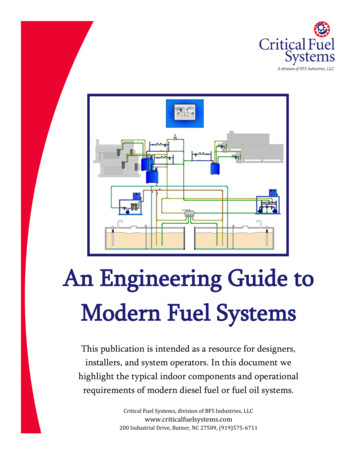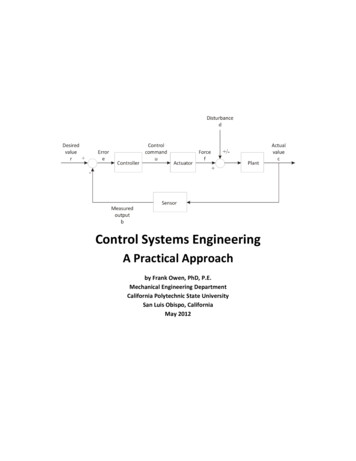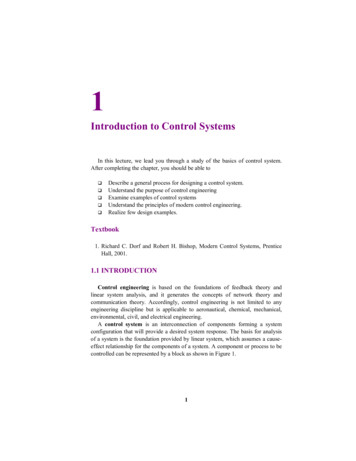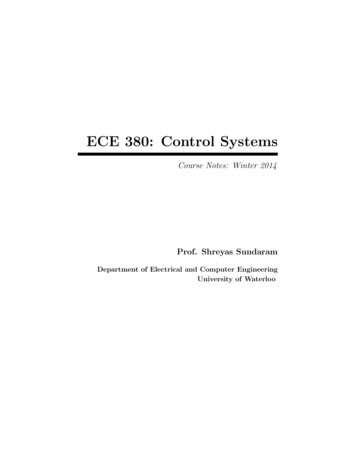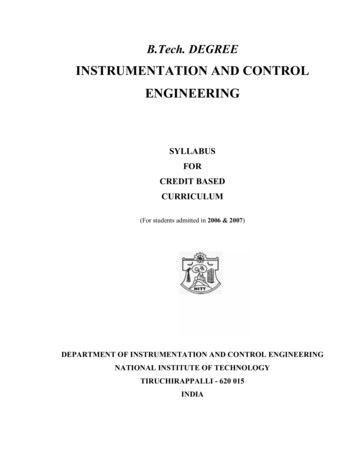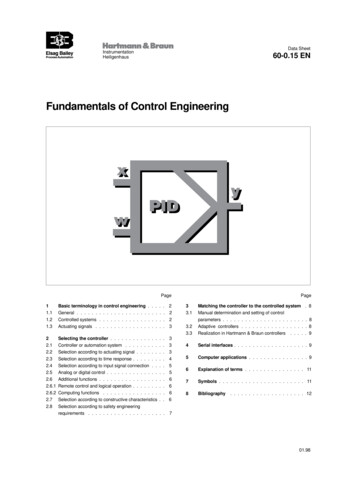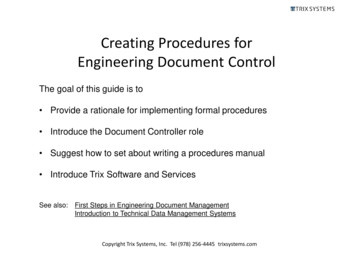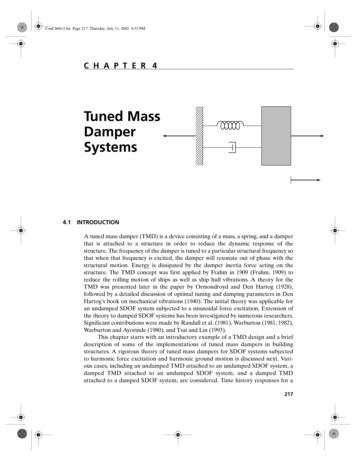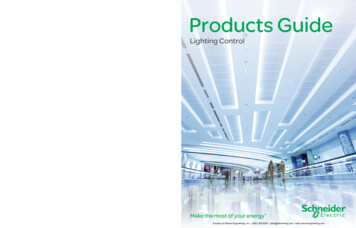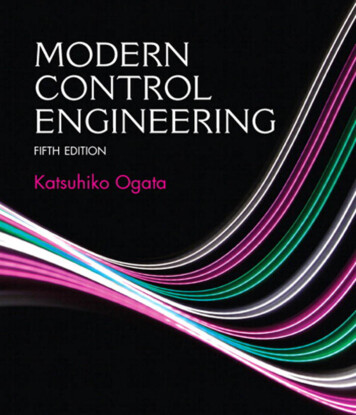
Transcription
Modern ControlEngineeringFifth EditionKatsuhiko OgataPrentice HallBoston Columbus Indianapolis New York San Francisco Upper Saddle RiverAmsterdam Cape Town Dubai London Madrid Milan Munich Paris Montreal TorontoDelhi Mexico City Sao Paulo Sydney Hong Kong Seoul Singapore Taipei Tokyo
VP/Editorial Director, Engineering/Computer Science: Marcia J. HortonAssistant/Supervisor: Dolores MarsSenior Editor: Andrew GilfillanAssociate Editor: Alice DworkinEditorial Assistant: William OpaluchDirector of Marketing: Margaret WaplesSenior Marketing Manager: Tim GalliganMarketing Assistant: Mack PattersonSenior Managing Editor: Scott DisannoArt Editor: Greg DullesSenior Operations Supervisor: Alan FischerOperations Specialist: Lisa McDowellArt Director: Kenny BeckCover Designer: Carole AnsonMedia Editor: Daniel SandinCredits and acknowledgments borrowed from other sources and reproduced, with permission, in thistextbook appear on appropriate page within text.MATLAB is a registered trademark of The Mathworks, Inc., 3 Apple Hill Drive, Natick MA 01760-2098.Copyright 2010, 2002, 1997, 1990, 1970 Pearson Education, Inc., publishing as Prentice Hall, One LakeStreet, Upper Saddle River, New Jersey 07458. All rights reserved. Manufactured in the United States ofAmerica. This publication is protected by Copyright, and permission should be obtained from the publisherprior to any prohibited reproduction, storage in a retrieval system, or transmission in any form or by anymeans, electronic, mechanical, photocopying, recording, or likewise. To obtain permission(s) to use materialfrom this work, please submit a written request to Pearson Education, Inc., Permissions Department, OneLake Street, Upper Saddle River, New Jersey 07458.Many of the designations by manufacturers and seller to distinguish their products are claimed astrademarks. Where those designations appear in this book, and the publisher was aware of a trademarkclaim, the designations have been printed in initial caps or all caps.Library of Congress Cataloging-in-Publication Data on File10 9 8 7 6 5 4 3 2 1ISBN 10: 0-13-615673-8ISBN 13: 978-0-13-615673-4
CContentsPrefaceChapter 11–11–21–31–41–52–6Introduction to Control Systems1Introduction1Examples of Control Systems4Closed-Loop Control Versus Open-Loop Control7Design and Compensation of Control Systems9Outline of the Book10Chapter 22–12–22–32–42–5ixMathematical Modeling of Control SystemsIntroduction13Transfer Function and Impulse-Response Function15Automatic Control Systems17Modeling in State Space29State-Space Representation of Scalar DifferentialEquation Systems35Transformation of Mathematical Models with MATLAB1339iii
2–7Linearization of Nonlinear Mathematical ModelsExample Problems and SolutionsProblemsChapter 360Mathematical Modeling of Mechanical Systemsand Electrical SystemsIntroduction3–2Mathematical Modeling of Mechanical Systems3–3Mathematical Modeling of Electrical SystemsProblems63728697Mathematical Modeling of Fluid Systemsand Thermal Systems4–1Introduction4–2Liquid-Level Systems4–3Pneumatic Systems1064–4Hydraulic Systems1234–5Thermal SystemsProblems101136140152Transient and Steady-State Response Analyses5–1Introduction5–2First-Order Systems5–3Second-Order Systems1645–4Higher-Order Systems1795–5Transient-Response Analysis with MATLAB5–6Routh’s Stability Criterion5–7Effects of Integral and Derivative Control Actionson System Performance2185–8Steady-State Errors in Unity-Feedback Control SystemsProblems159159161263183212Example Problems and SolutionsContents100100Example Problems and SolutionsChapter 56363Example Problems and Solutionsiv463–1Chapter 443231225
Chapter 6Control Systems Analysis and Designby the Root-Locus Method6–1Introduction6–2Root-Locus Plots6–3Plotting Root Loci with MATLAB6–4Root-Locus Plots of Positive Feedback Systems6–5Root-Locus Approach to Control-Systems Design6–6Lead Compensation6–7Lag Compensation6–8Lag–Lead Compensation6–9Parallel Compensation269270Chapter 7290303308311321330342Example Problems and SolutionsProblems269347394Control Systems Analysis and Design by theFrequency-Response Method7–1Introduction7–2Bode Diagrams7–3Polar Plots7–4Log-Magnitude-versus-Phase Plots7–5Nyquist Stability Criterion7–6Stability Analysis7–7Relative Stability Analysis7–8Closed-Loop Frequency Response of Unity-FeedbackSystems4777–9Experimental Determination of Transfer Functions3984034274434454544624867–10 Control Systems Design by Frequency-Response Approach7–11 Lead Compensation7–12 Lag Compensation493511Example Problems and SolutionsChapter 8521561PID Controllers and Modified PID Controllers8–1Introduction8–2Ziegler–Nichols Rules for Tuning PID ControllersContents4915027–13 Lag–Lead CompensationProblems398567567568v
8–38–48–58–68–7Design of PID Controllers with Frequency-ResponseApproach577Design of PID Controllers with Computational OptimizationApproach583Modifications of PID Control Schemes590Two-Degrees-of-Freedom Control592Zero-Placement Approach to Improve ResponseCharacteristics595Example Problems and Solutions614ProblemsChapter 99–19–29–39–49–59–69–7Control Systems Analysis in State SpaceChapter 10vi648Introduction648State-Space Representations of Transfer-FunctionSystems649Transformation of System Models with MATLAB656Solving the Time-Invariant State Equation660Some Useful Results in Vector-Matrix le Problems and 10–610–710–810–9641720Control Systems Design in State SpaceIntroduction722Pole Placement723Solving Pole-Placement Problems with MATLAB735Design of Servo Systems739State Observers751Design of Regulator Systems with Observers778Design of Control Systems with Observers786Quadratic Optimal Regulator Systems793Robust Control Systems806Example Problems and Solutions817Problems855Contents722
Appendix ALaplace Transform Tables859Appendix BPartial-Fraction Expansion867Appendix CVector-Matrix Algebra874References882Index886Contentsvii
This page intentionally left blank
PPrefaceThis book introduces important concepts in the analysis and design of control systems.Readers will find it to be a clear and understandable textbook for control system coursesat colleges and universities. It is written for senior electrical, mechanical, aerospace, orchemical engineering students. The reader is expected to have fulfilled the followingprerequisites: introductory courses on differential equations, Laplace transforms, vectormatrix analysis, circuit analysis, mechanics, and introductory thermodynamics.The main revisions made in this edition are as follows: The use of MATLAB for obtaining responses of control systems to various inputshas been increased. The usefulness of the computational optimization approach with MATLAB has beendemonstrated. New example problems have been added throughout the book. Materials in the previous edition that are of secondary importance have been deletedin order to provide space for more important subjects. Signal flow graphs weredropped from the book. A chapter on Laplace transform was deleted. Instead,Laplace transform tables, and partial-fraction expansion with MATLAB are presented in Appendix A and Appendix B, respectively. A short summary of vector-matrix analysis is presented in Appendix C; this will helpthe reader to find the inverses of n x n matrices that may be involved in the analysis and design of control systems.This edition of Modern Control Engineering is organized into ten chapters.The outline ofthis book is as follows: Chapter 1 presents an introduction to control systems. Chapter 2ix
deals with mathematical modeling of control systems. A linearization technique for nonlinear mathematical models is presented in this chapter. Chapter 3 derives mathematicalmodels of mechanical systems and electrical systems. Chapter 4 discusses mathematicalmodeling of fluid systems (such as liquid-level systems, pneumatic systems, and hydraulicsystems) and thermal systems.Chapter 5 treats transient response and steady-state analyses of control systems.MATLAB is used extensively for obtaining transient response curves. Routh’s stabilitycriterion is presented for stability analysis of control systems. Hurwitz stability criterionis also presented.Chapter 6 discusses the root-locus analysis and design of control systems, includingpositive feedback systems and conditionally stable systems Plotting root loci with MATLAB is discussed in detail. Design of lead, lag, and lag-lead compensators with the rootlocus method is included.Chapter 7 treats the frequency-response analysis and design of control systems. TheNyquist stability criterion is presented in an easily understandable manner.The Bode diagram approach to the design of lead, lag, and lag-lead compensators is discussed.Chapter 8 deals with basic and modified PID controllers. Computational approachesfor obtaining optimal parameter values for PID controllers are discussed in detail, particularly with respect to satisfying requirements for step-response characteristics.Chapter 9 treats basic analyses of control systems in state space. Concepts of controllability and observability are discussed in detail.Chapter 10 deals with control systems design in state space. The discussions includepole placement, state observers, and quadratic optimal control. An introductory discussion of robust control systems is presented at the end of Chapter 10.The book has been arranged toward facilitating the student’s gradual understandingof control theory. Highly mathematical arguments are carefully avoided in the presentation of the materials. Statement proofs are provided whenever they contribute to theunderstanding of the subject matter presented.Special effort has been made to provide example problems at strategic points so thatthe reader will have a clear understanding of the subject matter discussed. In addition,a number of solved problems (A-problems) are provided at the end of each chapter,except Chapter 1. The reader is encouraged to study all such solved problems carefully;this will allow the reader to obtain a deeper understanding of the topics discussed. Inaddition, many problems (without solutions) are provided at the end of each chapter,except Chapter 1. The unsolved problems (B-problems) may be used as homework orquiz problems.If this book is used as a text for a semester course (with 56 or so lecture hours), a goodportion of the material may be covered by skipping certain subjects. Because of theabundance of example problems and solved problems (A-problems) that might answermany possible questions that the reader might have, this book can also serve as a selfstudy book for practicing engineers who wish to study basic control theories.I would like to thank the following reviewers for this edition of the book: Mark Campbell, Cornell University; Henry Sodano, Arizona State University; and Atul G. Kelkar,Iowa State University. Finally, I wish to offer my deep appreciation to Ms.Alice Dworkin,Associate Editor, Mr. Scott Disanno, Senior Managing Editor, and all the people involved in this publishing project, for the speedy yet superb production of this book.Katsuhiko OgataxPreface
1Introductionto Control Systems1–1 INTRODUCTIONControl theories commonly used today are classical control theory (also called conventional control theory), modern control theory, and robust control theory. This bookpresents comprehensive treatments of the analysis and design of control systems basedon the classical control theory and modern control theory.A brief introduction of robustcontrol theory is included in Chapter 10.Automatic control is essential in any field of engineering and science. Automaticcontrol is an important and integral part of space-vehicle systems, robotic systems, modern manufacturing systems, and any industrial operations involving control of temperature, pressure, humidity, flow, etc. It is desirable that most engineers and scientists arefamiliar with theory and practice of automatic control.This book is intended to be a text book on control systems at the senior level at a college or university. All necessary background materials are included in the book. Mathematical background materials related to Laplace transforms and vector-matrix analysisare presented separately in appendixes.Brief Review of Historical Developments of Control Theories and Practices.The first significant work in automatic control was James Watt’s centrifugal governor for the speed control of a steam engine in the eighteenth century. Othersignificant works in the early stages of development of control theory were due to1
Minorsky, Hazen, and Nyquist, among many others. In 1922, Minorsky worked onautomatic controllers for steering ships and showed how stability could be determined from the differential equations describing the system. In 1932, Nyquistdeveloped a relatively simple procedure for determining the stability of closed-loopsystems on the basis of open-loop response to steady-state sinusoidal inputs. In 1934,Hazen, who introduced the term servomechanisms for position control systems,discussed the design of relay servomechanisms capable of closely following a changing input.During the decade of the 1940s, frequency-response methods (especially the Bodediagram methods due to Bode) made it possible for engineers to design linear closedloop control systems that satisfied performance requirements. Many industrial controlsystems in 1940s and 1950s used PID controllers to control pressure, temperature, etc.In the early 1940s Ziegler and Nichols suggested rules for tuning PID controllers, calledZiegler–Nichols tuning rules. From the end of the 1940s to the 1950s, the root-locusmethod due to Evans was fully developed.The frequency-response and root-locus methods, which are the core of classical control theory, lead to systems that are stable and satisfy a set of more or less arbitrary performance requirements. Such systems are, in general,
This edition of Modern Control Engineering is organized into ten chapters.The outline of this book is as follows: Chapter 1 presents an introduction to control systems. Chapter 2. deals with mathematical modeling of control systems.A linearization technique for non-linear mathematical models is presented in this chapter.Chapter 3 derives mathematical models of mechanical systems and electrical .

